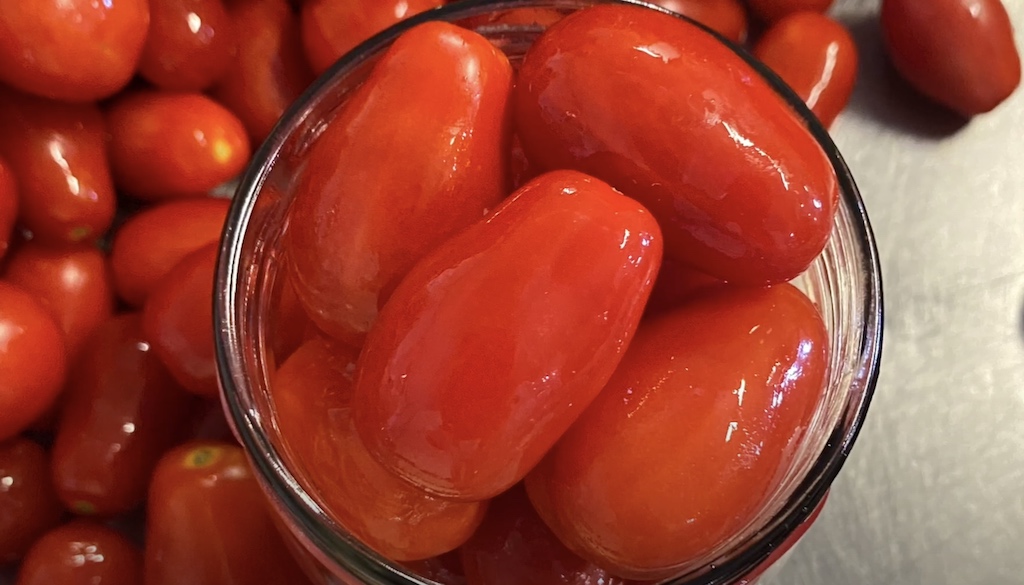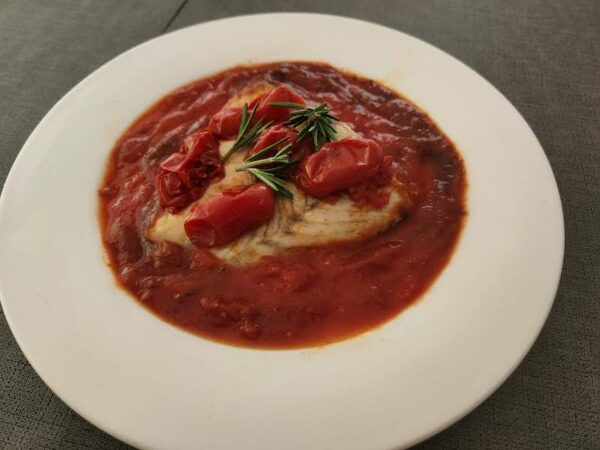We’re back again with the next installment of: Know Your Italian Tomatoes! Today we’ll be discussing everything you need to know about Corbarino tomatoes – including what to cook with them and how to get your hands on them.
General Description
Corbarino tomatoes are characteristically very sweet with low acidity, with juicy pulp and thin skin. They have a hint of a “mineral” taste that is reminiscent of the salinity of the nearby Mediterranean, which is perhaps why they are so great with seafood dishes.
These tomatoes are a particularly rare variety grown on the slopes of Monti Lattari in Corbara – a small town in the region of Campania. Geographically, this is southeast of Naples, south of Mount Vesuvius, and importantly near the coast of the Mediterranean.
This particular area of Italy is hotbed of amazingly delicious tomatoes. Both San Marzano and Piennolo del Vesuvio tomatoes originate from this same region.
Corbarino Nutrition
There isn’t a huge amount of variation in the nutritional profile of different types of tomatoes.
All tomatoes are pretty famous for being high in lycopene – an antioxidant known to have positive effects on aging and to inhibit certain types of cancer. Unless you’re on an acid-restricted diet tomatoes are great for you, and corbarino are definitely included in that list.
Corbarinos are definitely one of the sweeter varieties of tomato, so expect a bit higher sugar content.
What Recipes are best with Corbarinos?
Any recipe in which small, sweet tomatoes are appropriate would be great with corbarinos. In general, they’re really exceptional for two types of dishes: seafood and pizza. Don’t sleep on them for soups and stews either.
Did you know that there are official Napoletana pizza rules? (I wish they had those everywhere so that I wouldn’t have to see pineapple on pizza menus ever again.) These pizza rules include allowable varieties of tomatoes that can be used on pizzas. As you probably guessed, Corbarinos make the list along with the other tomatoes from the region – San Marzanos and Piennolos. Interestingly, my research did not turn up any specific corbarino pizza sauce recipes on the internet. I guess folks using them don’t like to talk about it! Secret weapons are important.
While this isn’t an Italian beverage by any stretch of the imagination, they’re also fantastic as the base of a Bloody Mary. Remember that next time you wake up in bad shape after a late night of drinking too much grappa.
Recipe roundup:
- Spaghettoni with Corbarino Tomatoes, Provolone Fondue, and Basil
- Broiled Sea Bass with Corbarino Tomatoes
- Pizza “In The Wheel”
- Penne Pasta with Mussels
- Pesce alla Pizzaiola (in Italian)
Corbarino Substitute
- Datterini – are a mini-plum variety that are also super sweet.
- Piennolo del Vesuvio – are grown in the same region and are also small and sweet, but have a slightly bitter finish to the taste.
- Cherry or Grappolo Pachino – the smaller varieties of the Pachino tomatoes are delicious and not dissimilar in flavor profile to the Corbarino. These grow on the coast in Sicily, and similarly benefit from the salinity of the water and air.
- Cherry – are more acidic but probably about as sweet
- Grape – depending on where you get them fresh grape tomatoes are often pretty bland, but if they’re in season or you get them from a decent farmers market they could be a good substitute. Or if you’re looking for canned, that would be great too.
Where to Buy Corbarino Tomatoes
All this advice applies to the US. For our friends in other countries, I’d love to hear how you order corbarinos!
Fresh
If you want fresh, raw corbarino tomatoes, you are going to have your work cut out for you! Your best chance is likely in major metro areas, especially if there is a sizeable Italian population (or at least a large number of Italian restaurants). If you find them fresh on a local restaurant’s menu, don’t hesitate to ask to talk to the chef and ask them what produce supplier they get theirs from. Corbarino are unlikely to appear fresh on a menu however, and if they did you might not want them anyway. Their special flavor is a product of their environment, and that environment is probably not going to be found in many other places in the world.
Also, go to your local Italian grocery store and ask there. There’s a chance they may have them if they have fresh produce, but my local shops don’t.
Alternately, if your city or town has a sizable farmers’ market where there is a lot of specialty and/or heirloom produce, you may be able to find someone growing them. They’ll only be available in the growing season, but that’s a good thing – they’ll be ripened on the vine and taste incredible.
Canned/Jarred
If you want canned tomatoes, they will probably be significantly easier to track down than fresh ones. The corbarino is a popular tomato for fish dishes as well as Neapolitan-style pizza sauce, so it should be common in your local restaurants and thus easier to find than something like datterini.
Your first stop should always be at your local Italian grocery store – it’s reasonably likely they have them canned/jarred. Always, if it comes down to buying locally from your local shop and Amazon, do the right thing and support your shop!
If for some reason they don’t, you may be able to find them on the shelf if you have a fancy grocery store (Whole Foods, Sprouts, Fresh Market, etc).
Don’t worry if you can’t find them in a store, there are a handful of places you can order them online…
- Maida Farm – Corbarino tomatoes
- Coluccio Corbarini Cherry Tomatoes
- i Sapori di Corbara – Corbara Pomodorini
- La Fiammante – Corbarino Cherry Tomatoes
How to grow Corbarino tomatoes
If you happen to have a green thumb and really want fresh tomatoes, you can always grow them yourself. If you can grow *any* variety of tomatoes where you live, you’ll be able to grow these. They want full sun, warm and well-drained soil, and the temperature has to stay below 95ºF (and below 85ºF at night). You should be able to get from seed to fruit within 75 days in ideal conditions (healthy soil, appropriate water, full sunlight, and goldilocks temperatures).
Seeds are surprisingly difficult to find, even online. Here are a few places you can buy seeds online if your local nursery doesn’t carry them.


